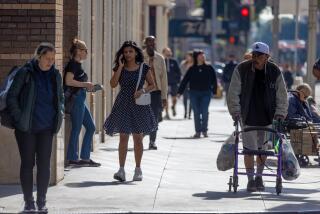American workforce has lowest mobility rate since WWII
- Share via
Reporting from Washington — Single and unemployed, Adam Holguin knows he could find better opportunities outside California, where the unemployment rate is 12.3%. But with little savings, and college loans and credit card bills to pay, he can’t afford to leave.
“I don’t have the finances at this time to move,” said Holguin, 31, of Rancho Cucamonga.
One of the hallmarks of the American worker has been mobility -- the speed with which people like Holguin have moved to find opportunities. But the recession of the last two years has produced a profound change, creating conditions that have tethered many people where they are.
Since 2007, the nation’s mobility rate has fallen to its lowest level since World War II, says William Frey, a demographer at the Brookings Institution. His findings are consistent with the Census Bureau’s report this week that population growth has slowed sharply in Sun Belt states, while the outflow of residents from California, New York and breadbasket states such as Nebraska and North Dakota has eased.
Frey and other experts believe that the U.S. will eventually return to its traditional pattern of robust mobility and migration -- from North to South and West, and from the industrial Midwest to the coasts. But as the nation struggles out of the recession and hiring slowly resumes, there are signs that many people will stay where they are, rooted by mortgages, other financial issues or age.
For employers, that means workers may be harder to find and thus costlier. And that could make it tougher to reduce the nation’s double-digit unemployment rate.
“Economically, it means labor will be less accessible,” Frey said.
Home ownership is a big factor. In 1940, 44% of U.S. households owned homes, but by 2005 that had risen to 69%. And with a soft housing market, selling isn’t easy.
Renters aren’t necessarily more mobile. The older the worker, the less likely he or she is to move.
“Moving is not an option since I have never lived anywhere else and have no family,” said Melody Boyd, who rents in Los Angeles and has been seeking accounting work for more than a year. She preferred to keep her age private.
Demographer Frey says 40% of the people in the U.S. who relocate across state lines are in their 20s. In past years, Midwestern states in particular have seen an exodus of young adults who leave for college and jobs on the coasts.
But that, too, is shifting. Between July 2006 and July 2007, shortly before the recession, Nebraska saw a net loss of 5,538 residents. But in the 12 months ending July 2009, the Census Bureau said, the net outflow slowed to fewer than 1,000.
Kansas saw a similar trend, and North Dakota’s population actually grew with migration.
Some demographers argue that the recession could produce long-term changes. In Nebraska, for example, where the unemployment rate is 4.5%, many residents who left for college in other states are returning because they can’t find work elsewhere, says Louis Pol, dean of the College of Business Administration at the University of Nebraska in Omaha.
A demographer by training, Pol says Omaha and some other Midwestern cities have built a more diversified economy and a stronger cultural community that could help retain and attract young workers.
“We might see some long-term shifts, even though they might be small,” he said.
More to Read
Inside the business of entertainment
The Wide Shot brings you news, analysis and insights on everything from streaming wars to production — and what it all means for the future.
You may occasionally receive promotional content from the Los Angeles Times.











